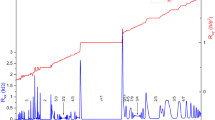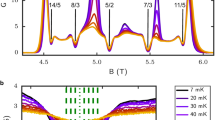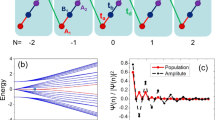Abstract
Strong interactions and topology drive a wide variety of correlated ground states. Some of the most interesting of these ground states, such as fractional quantum Hall states and fractional Chern insulators, have fractionally charged quasiparticles. Correlations in these phases are captured by the binding of electrons and vortices into emergent particles called composite fermions. Composite fermion quasiparticles are randomly localized at high levels of disorder and may exhibit charge order when there is not too much disorder in the system. However, more complex correlations are predicted when composite fermion quasiparticles cluster into a bubble, and then these bubbles order on a lattice. Such a highly correlated ground state is termed the bubble phase of composite fermions. Here we report the observation of such a bubble phase of composite fermions, evidenced by the re-entrance of the fractional quantum Hall effect. We associate this re-entrance with a bubble phase with two composite fermion quasiparticles per bubble. Our results demonstrate the existence of a new class of strongly correlated topological phases driven by clustering and charge ordering of emergent quasiparticles.
This is a preview of subscription content, access via your institution
Access options
Access Nature and 54 other Nature Portfolio journals
Get Nature+, our best-value online-access subscription
$29.99 / 30 days
cancel any time
Subscribe to this journal
Receive 12 print issues and online access
$209.00 per year
only $17.42 per issue
Buy this article
- Purchase on Springer Link
- Instant access to full article PDF
Prices may be subject to local taxes which are calculated during checkout




Similar content being viewed by others
Data availability
Data are available upon request. Source data are provided with this paper.
References
Klitzing, K. V., Dorda, G. & Pepper, M. New method for high-accuracy determination of the fine-structure constant based on quantized Hall resistance. Phys. Rev. Lett. 45, 494–497 (1980).
Zhitenev, N. B. et al. Imaging of localized electronic states in the quantum Hall regime. Nature 404, 473–476 (2000).
Chen, Y. et al. Microwave resonance of the 2D Wigner crystal around integer Landau fillings. Phys. Rev. Lett. 91, 016801 (2003).
Shayegan, M. Wigner crystals in flat band 2D electron systems. Nat. Rev. Phys. 4, 212–213 (2022).
Tiemann, L., Rhone, T. D., Shibata, N. & Muraki, K. NMR profiling of quantum electron solids in high magnetic fields. Nat. Phys. 10, 648–652 (2014).
Jang, J., Hunt, B. M., Pfeiffer, L. N., West, K. W. & Ashoori, R. C. Sharp tunnelling resonance from the vibrations of an electronic Wigner crystal. Nat. Phys. 13, 340–344 (2017).
Liu, Y. et al. Observation of reentrant integer quantum Hall states in the lowest Landau level. Phys. Rev. Lett. 109, 036801 (2012).
Myers, S. A., Huang, H., Pfeiffer, L. N., West, K. W. & Csáthy, G. A. Magnetotransport patterns of collective localization near ν = 1 in a high-mobility two-dimensional electron gas. Phys. Rev. B 104, 045311 (2021).
Shingla, V., Myers, S. A., Pfeiffer, L. N., Baldwin, K. W. & Csáthy, G. A. Particle-hole symmetry and the reentrant integer quantum Hall Wigner solid. Commun. Phys. 4, 204 (2021).
Zhou, H., Polshyn, H., Taniguchi, T., Watanabe, K. & Young, A. F. Solids of quantum Hall skyrmions in graphene. Nat. Phys. 16, 154–158 (2020).
Koulakov, A. A., Fogler, M. M. & Shklovskii, B. I. Charge density wave in two-dimensional electron liquid in weak magnetic field. Phys. Rev. Lett. 76, 499–502 (1996).
Moessner, R. & Chalker, J. T. Exact results for interacting electrons in high Landau levels. Phys. Rev. B 54, 5006–5015 (1996).
Lilly, M. P., Cooper, K. B., Eisenstein, J. P., Pfeiffer, L. N. & West, K. W. Evidence for an anisotropic state of two-dimensional electrons in high Landau levels. Phys. Rev. Lett. 82, 394–397 (1999).
Du, R. R. et al. Strongly anisotropic transport in higher two-dimensional Landau levels. Solid State Commun. 109, 389–394 (1999).
Cooper, K. B., Lilly, M. P., Eisenstein, J. P., Pfeiffer, L. N. & West, K. W. Insulating phases of two-dimensional electrons in high Landau levels: observation of sharp thresholds to conduction. Phys. Rev. B 60, R11285 (1999).
Eisenstein, J. P., Cooper, K. B., Pfeiffer, L. N. & West, K. W. Insulating and fractional quantum Hall states in the first excited Landau level. Phys. Rev. Lett. 88, 076801 (2002).
Fu, X. et al. Two-and three-electron bubbles in AlxGa1−xAs/Al0.24Ga0.76As quantum wells. Phys. Rev. B 99, 161402 (2019).
Ro, D. et al. Electron bubbles and the structure of the orbital wave function. Phys. Rev. B 99, 201111 (2019).
Chen, S. et al. Competing fractional quantum Hall and electron solid phases in graphene. Phys. Rev. Lett. 122, 026802 (2019).
Stormer, H. L., Tsui, D. C. & Gossard, A. C. The fractional quantum Hall effect. Rev. Mod. Phys. 71, S298–S305 (1999).
Du, X., Skachko, I., Duerr, F., Luican, A. & Andrei, E. Y. Fractional quantum Hall effect and insulating phase of Dirac electrons in graphene. Nature 462, 192–195 (2009).
Bolotin, K. I., Ghahari, F., Shulman, M. D., Stormer, H. L. & Kim, P. Observation of the fractional quantum Hall effect in graphene. Nature 462, 196–199 (2009).
Spanton, E. M. et al. Observation of fractional Chern insulators in a van der Waals heterostructure. Science 360, 62–66 (2018).
Xie, Y. et al. Fractional Chern insulators in magic-angle twisted bilayer graphene. Nature 600, 439–443 (2021).
Pierce, A. T. et al. Unconventional sequence of correlated Chern insulators in magic-angle twisted bilayer graphene. Nat. Phys. 17, 1210–1215 (2021).
Laughlin, R. B. Anomalous quantum Hall effect: an incompressible quantum fluid with fractionally charged excitations. Phys. Rev. Lett. 50, 1395–1398 (1983).
Jain, J. K. Composite-fermion approach for the fractional quantum Hall effect. Phys. Rev. Lett. 63, 199–202 (1989).
Martin, J. et al. Localization of fractionally charged quasi-particles. Science 305, 980–983 (2004).
Yi, H. & Fertig, H. A. Laughlin-Jastrow-correlated Wigner crystal in a strong magnetic field. Phys. Rev. B 58, 4019–4027 (1998).
Narevich, R., Murthy, G. & Fertig, H. A. Hamiltonian theory of the composite-fermion Wigner crystal. Phys. Rev. B 64, 245326 (2001).
Chang, C. C., Jeon, G. S. & Jain, J. K. Microscopic verification of topological electron-vortex binding in the lowest Landau-level crystal state. Phys. Rev. Lett. 94, 016809 (2005).
He, W. J. et al. Phase boundary between the fractional quantum Hall liquid and the Wigner crystal at low filling factors and low temperatures: a path integral Monte Carlo study. Phys. Rev. B 72, 195306 (2005).
Chang, C. C., Töke, C., Jeon, G. S. & Jain, J. K. Competition between composite-fermion-crystal and liquid orders at ν = 1∕ 5. Phys. Rev. B 73, 155323 (2006).
Archer, A. C., Park, K. & Jain, J. K. Competing crystal phases in the lowest Landau level. Phys. Rev. Lett. 111, 146804 (2013).
Zhao, J., Zhang, Y. & Jain, J. K. Crystallization in the fractional quantum Hall regime induced by Landau-level mixing. Phys. Rev. Lett. 121, 116802 (2018).
Zuo, Z. W. et al. Interplay between fractional quantum Hall liquid and crystal phases at low filling. Phys. Rev. B 102, 075307 (2020).
Archer, A. C. & Jain, J. K. Static and dynamic properties of type-II composite fermion Wigner crystals. Phys. Rev. B 84, 115139 (2011).
Zhu, H. et al. Observation of a pinning mode in a Wigner solid with ν = 1/3 fractional quantum Hall excitations. Phys. Rev. Lett. 105, 126803 (2010).
Lee, S. Y., Scarola, V. W. & Jain, J. K. Structures for interacting composite fermions: stripes, bubbles, and fractional quantum Hall effect. Phys. Rev. B 66, 085336 (2002).
Goerbig, M. O., Lederer, P. & Smith, C. M. Possible reentrance of the fractional quantum hall effect in the lowest Landau level. Phys. Rev. Lett. 93, 216802 (2004).
Du, R. R. et al. Fractional quantum Hall effect around ν = 3/2: composite fermions with a spin. Phys. Rev. Lett. 75, 3926–3929 (1995).
Liu, Y. et al. Spin polarization of composite fermions and particle-hole symmetry breaking. Phys. Rev. B 90, 085301 (2014).
Eisenstein, J. P., Stormer, H. L., Pfeiffer, L. N. & West, K. W. Evidence for a phase transition in the fractional quantum Hall effect. Phys. Rev. Lett. 62, 1540–1543 (1989).
Deng, N. et al. Collective nature of the reentrant integer quantum Hall states in the second Landau level. Phys. Rev. Lett. 108, 086803 (2012).
Goerbig, M. O., Lederer, P. & Smith, C. M. Competition between quantum-liquid and electron-solid phases in intermediate Landau levels. Phys. Rev. B 69, 115327 (2004).
Pan, W. et al. Fractional quantum Hall effect of composite fermions. Phys. Rev. Lett. 90, 016801 (2003).
Samkharadze, N., Arnold, I., Pfeiffer, L. N., West, K. W. & Csáthy, G. A. Observation of incompressibility at ν = 4/11 and ν = 5/13. Phys. Rev. B 91, 081109(R) (2015).
Schreiber, K. A. & Csáthy, G. A. Competition of pairing and nematicity in the two-dimensional electron gas. Annu. Rev. Condens. Matter Phys. 11, 17–35 (2020).
Acknowledgements
We acknowledge useful discussions with J. Jain and V. Scarola. Measurements at Purdue were supported by the NSF DMR Grant No. 1904497. The sample growth effort of L.N.P., K.W.W. and K.W.B. of Princeton University was supported by the Gordon and Betty Moore Foundation Grant No. GBMF 4420 and the National Science Foundation MRSEC Grant No. DMR-1420541.
Author information
Authors and Affiliations
Contributions
V.S. and A.K. performed low-temperature transport measurements. L.N.P., K.W.W. and K.W.B. produced molecular beam epitaxy-grown GaAs/AlGaAs samples and characterized them. V.S., H.H. and G.A.C. analysed the data and wrote the paper.
Corresponding author
Ethics declarations
Competing interests
The authors declare no competing interests.
Peer review
Peer review information
Nature Physics thanks the anonymous reviewers for their contribution to the peer review of this work.
Additional information
Publisher’s note Springer Nature remains neutral with regard to jurisdictional claims in published maps and institutional affiliations.
Extended data
Extended Data Fig. 1 Multiple observations of the RFQHS.
Several longitudinal magnetoresistance 𝑅𝑥𝑥 and Hall resistance 𝑅x𝑦 measurements. Panels a and b have data from Sample 1, collected after cycling the sample to room temperature. Panel c has data from Sample 2. All panels exhibit the RFQHS, as evident from a splitting of the longitudinal magnetoresistance into two peaks and reentrance of the Hall resistance to Rxy = 3h/5e2.
Extended Data Fig. 2 The longitudinal magnetoresistance Rxx and Ryy as measured along two mutually perpendicular crystal directions and the Hall resistance.
Data were collected from Sample 1 at T = 12 mK. While there are small but noticeable differences in the two longitudinal magnetoresistance traces, at the formation of the RFQHS the longitudinal magnetoresistance is nearly vanishing for both crystal directions and it is nearly isotropic. Panels a and b show data collected along two mutually perpendicular crystal axes of the GaAs crystal.
Supplementary information
Supplementary Information
Supplementary text and references.
Source data
Source Data Fig. 2
Raw data for Fig. 2 of the main text.
Source Data Fig. 3
Raw data for Fig. 3 of the main text.
Source Data Extended Data Fig. 1
Raw data for Extended Data Fig. 1 of the Supplementary Information.
Source Data Extended Data Fig. 2
Raw data for Extended Data Fig. 2 of the Supplementary Information.
Rights and permissions
Springer Nature or its licensor (e.g. a society or other partner) holds exclusive rights to this article under a publishing agreement with the author(s) or other rightsholder(s); author self-archiving of the accepted manuscript version of this article is solely governed by the terms of such publishing agreement and applicable law.
About this article
Cite this article
Shingla, V., Huang, H., Kumar, A. et al. A highly correlated topological bubble phase of composite fermions. Nat. Phys. 19, 689–693 (2023). https://doi.org/10.1038/s41567-023-01939-2
Received:
Accepted:
Published:
Issue Date:
DOI: https://doi.org/10.1038/s41567-023-01939-2



